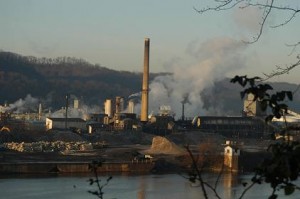
The referenced media source is missing and needs to be re-embedded.
By Jennifer Peters, National Water Campaigns Coordinator
This week we are blogging about the Clean Water Act, which turns 40 on October 18th. Because of this landmark legislation, many rivers, streams, lakes, and beaches are much cleaner than they were forty years ago. Though we’ve made significant progress in combating water pollution, there have been no updates to the Act since 1987 and it is beginning to show its age.
The Clean Water Act requires the Environmental Protection Agency (EPA) to review effluent limitations (i.e. wastewater discharges from utilities or sewage plants) and revise them as “appropriate” at least every five years. Wastewater discharges from coal fired power plants contain an increasingly toxic mix of heavy metals and other pollutants, but the discharge guidelines for these facilities have not been updated since 1982. After completing a detailed study of the industry’s wastewater discharges, EPA concluded that discharges from coal fired power plants account for nearly 60% of all unregulated toxic and nonconventional pollutants.
Wastewater from coal plants is a nasty mix of arsenic, selenium, lead, mercury and other elements that can be detrimental to fish and other aquatic life and can threaten human health when they contaminate drinking water supplies. As you may remember from your high school chemistry class, elements do not breakdown, and the movement of elements in an aquatic environment is a major concern. Elements like mercury are also quick accumulate in the food chain, which is why it is unsafe to eat fish caught in rivers that are contaminated with certain heavy metals.
To address concerns about airborne mercury and other toxics, new clean air rules require coal fired power plants to dramatically reduce the amount of pollutants coming out of their smokestacks. These pollutants are now captured by air pollution control devices but the irony is that many of these pollutants still end up in the environment when discharged as wastewater. Clearly the wastewater regulations for power plants have not kept pace with these improved air pollution control technologies.
In 2010 EPA agreed in a consent decree with Defenders of Wildlife to update effluent guidelines for coal fired power plants by 2014. The Agency was supposed to have a proposal available for public comment this past July but that deadline has been pushed back to December 2012. We’re eagerly awaiting EPA’s proposal because current regulations do not adequately address the majority of toxics that coal-fired power plants discharge into surface water.
We expect coal utilities and their friends in Congress to call out EPA’s new wastewater rule as another example of a “sweeping new job-killing regulation.” This view is ridiculous because EPA’s “new” rule to reduce toxic discharges from coal-fired power plants is 30 years overdue. The truth is this industry has been grossly under-regulated for decades and has profited from lax pollution controls at the expense of public health and the environment. Fortunately when Congress passed the Clean Water Act in 1972 they were wise enough to foresee this type of political conflict and included a provision in the law that allows citizens to hold polluters liable when government fails to take action.Related Posts
Stay Informed
Get the latest updates and actions:
Thanks for signing up!
There was a problem processing your signup. Please try again.


